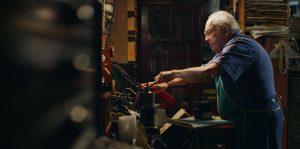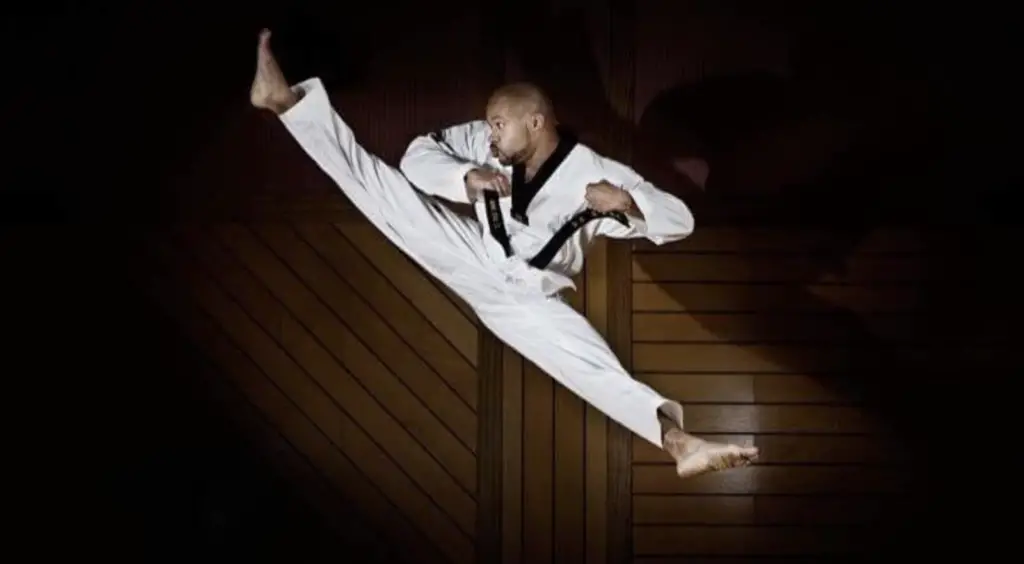
Letterpress printing is a process in which a number of identical copies of a letter or poster can be copied over and over again from a printing press. The fonts or pictures can be made from material as different as wood, linoleum, or metal. With the advent of offset typing, printing presses, and letterpress specifically, saw a considerable decline, to the point of almost extinction. That pretty much sums up everything the documentary Pressing On: The Letterpress Film teaches the audience about this technique.
The opening sets up the audience for a much more captivating experience than the film ultimately delivers. Jim Daggs, the owner of Ackley Publishing, recounts when he first discovered a printing press. As a boy playing about town with a friend of his, he hears a strange noise. He follows it to the back door of a printing shop, where he was instantly mesmerized. Daggs began hanging out there often, and eventually, the owner showed the young lad the ins and outs of the machinery.
This is told via an interview with Daggs intercut with a re-enactment of that fateful day. It boasts strong cinematography and a whimsical, almost magical vibe that nimbly entices the audience to discover more about letterpress printing. After this opening, the movie settles into a blandly directed talking heads documentary. One that as written and directed by Erin Beckloff and Andrew P. Quinn is only accessible if the viewer is already intimately familiar with printing presses, the most famous brands of printing presses, and the terminology associated with all its accouterments.

“…the owner showed the young lad the ins and outs of the machinery.”
And to be entirely fair to Pressing On: The Letterpress Film, its primary directive, if you will, is to highlight the efforts of the modern collectors, hobbyists, and workers to keep letter-pressing alive as an art form. And it should be noted, the film does discuss leading- the process of spacing outlines between each other. It is the same terminology that is used in modern word programs such as Microsoft Office or Google Docs.
However, in order for this to be achieved, it needs to ensure the audience understands these machines and how they operate. But it fails to explain even the most basic of parts. The ink is spread onto a plate looking thing, but after the movie was over, I had no idea where that plate was placed on the press, nor exactly how the ink from the plate rolled over onto the letters.
Ever heard of a ‘Kelsey’, much less know what it does? Research tells me that it is a brand of printing press, useful information the movie should have told the audience. Have you heard of a line-o-scribe? Do you know what it does? How about a showcard press? By the end of the movie, I knew these things existed and nothing beyond that. How is the audience meant to invest in the movie’s arguments when the community it advocates is kept at an arm’s distance?

“…strong cinematography and a whimsical, almost magical vibe enticing the audience to discover more about letterpress printing…”
The interviewees are all a lively bunch who are enthused to discuss their life’s work (in some cases it is just a hobby) and show off their collections of printing presses. Adam and Tammy Winn are a married couple, and the film follows their escapades in rescuing a piece (I don’t know if that is the right word) from the basement of a friendly family’s house. It involves a tow truck, makeshift ramps, and several hours of work. They also sell prints at their local farmer’s market and business is steadily picking up for them. Jim Moran is a wealth of knowledge and is apparently happy to share all he knows. The aforementioned Daggs is a sweet man, pleased that letter-pressing is gaining some traction after its brush with absolute irrelevance.
Other people interviewed include Stephanie Carter, who is the most philosophical and interesting of all the players present; Richard Hopkins who really likes creating these posters by hand; and Paul Akens who runs the Platen Press Museum in Zion, Illinois. All of them have something interesting to say, too bad that movie fails to provide a frame of reference that would make it meaningful to the audience.
Pressing On: The Letterpress Film is boring to watch despite the zeal of the people it follows. The directing fails to galvanize the audience to its core message. This is mostly the fault of the screenplay, which can’t be bothered to describe the operation of the very machines it purports to love. Exclusively for letterpress fanatics, and even then, I doubt they’d get much out of this title.

Pressing On: The Letterpress Film (2018) Directed by Erin Beckloff, Andrew P. Quinn. Written by Erin Beckloff, Andrew P. Quinn. Starring Jim Daggs, Paul Aken, Stephanie Carter, Richard Hopkins, Adam Winn, Tammy Winn, Jim Moran.
3 out of 10

